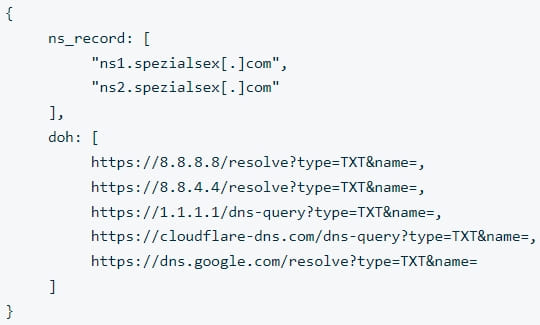
The Chinese threat group 'ChamelGang' infects Linux devices with a previously unknown implant named 'ChamelDoH,' allowing DNS-over-HTTPS communications with attackers' servers.
The particular threat actor was first documented back in September 2021 by Positive Technologies; however, the researchers only focused on the Windows toolkit.
A report published yesterday by Stairwell and shared with BleepingComputer describes a new Linux implant written in C++ that expands the threat actor's intrusion arsenal and, by extension, the attackers' indicators of compromise.
The link between ChamelGang and the new Linux malware is based on a domain previously associated with the threat actor and a custom privilege elevation tool observed by Positive Technologies in past ChamelGang campaigns.
DNS-over-HTTPS for malware communication
The DNS (domain name system) protocol is used by software and operating systems to resolve human-readable hostnames into IP addresses, which are then used to make network connections.
However, DNS queries are sent as unencrypted, plain text, allowing organizations, ISPs, and others to monitor the DNS requests.
As this is considered a privacy risk and allows governments to censor the Internet, a new DNS protocol named DNS-over-HTTPS was created to encrypt DNS queries so they cannot be snooped on.
However, this is a double-edged sword, as malware can use it as an effective encrypted communication channel, making it harder for security software to monitor for malicious network communication.
In the case of ChamelDoH, DNS-over-HTTPS provides encrypted communication between an infected device and the command and control server, making malicious queries indistinguishable from regular HTTPS traffic.
Additionally, DoH can help bypass local DNS servers by using DoH-compatible servers provided by reputable organizations, which was not seen in this case.
Finally, because the DNS requests use legitimate DoH servers from Google and Cloudflare, blocking them is practically impossible without impacting legitimate traffic.
ChamelDoH uses two keys stored in its JSON configuration, "ns_record" and "doh," to get C2 hostnames and a list of legitimate DoH cloud providers that can be abused for performing DoH queries.

All malware's communications are encrypted using AES128 and a modified base64 encoding that contains substitutes for non-alphanumeric characters. The transmitted data is then appended as hostnames to the listed malware command and control servers.
This modification allows the malware to issue TXT requests for domains containing the encoded command and control server (C2) communications, obscuring the nature of those requests and reducing the likelihood of being detected.
For example, when querying the TXT record, a DoH query from the malware would use <encoded_data>.ns2.spezialsec[.].com. The malicious name server receiving the query would then extract and decrypt the encoded portion to receive the exfiltrated data from the infected device.
The C2 would respond with an encoded TXT record containing the commands the malware should execute on the infected device.

Upon execution, the malware will gather basic data about its host, including the name, IP address, CPU architecture, and system version, and generate a unique ID.
Stairwell researchers found that ChamelDoH supports the following commands that its operators can issue remotely via the TXT records received in DNS-over-HTTPS requests:
- run – Execute a file/shell command
- sleep – Set the number of seconds until the next check-in
- wget – Download a file from a URL
- upload – Read and upload a file
- download – Download and write a file
- rm – Delete a file
- cp – Copy a file to a new location
- cd – Change the working directory
Stairwell's analysis showed that ChamelDoH was first uploaded to VirusTotal in December 2022.
By the time of writing this, it is not flagged as malicious by any of the platform's AV engines.


Comments
alozzy - 10 months ago
It was just a matter of time before attacks that leverage DoH appeared. DoH is one of the stupidest ideas in a long time, virtually impossible to defend without using a web proxy as a MITM to decrypt, inspect (for DoH mimetypes), and reencrypt HTTPS connection streams. Super frustrating!
h_b_s - 10 months ago
"It was just a matter of time before attacks that leverage DoH appeared. DoH is one of the stupidest ideas in a long time, virtually impossible to defend without using a web proxy as a MITM to decrypt, inspect (for DoH mimetypes), and reencrypt HTTPS connection streams. Super frustrating!"
Only if you're an incompetent administrator who can't figure out how to use traffic analysis tools to find anomalous connections. Or can't find anomalous changes to their Linux deployment files. In either case, the admin isn't worth a hill of beans. This is Linux Admin and NOC class material.
Yes I did read the article. DoH doesn't prevent administrators from seeing where network connections are destined. It only stops a MitM from interfering with those connections. Traffic analysis will still see the resultant connections going someplace that doesn't fit with the rest of the site' traffic patterns, especially if it begins suddenly and continues regularly thereafter. This is why DoH is a bit of a red herring for trying to ensure ISP privacy if it's not paired with other tunneling measures.
Even that's unnecessary if you're using various methods to check for file and executable integrity because those should detect any changes in file structure or image integrity before the connections are even made.
logan_campbell - 10 months ago
Network admins are always reluctant to change anything in their network, in their mindset, and to follow the latest threats. They still want to use the good-old rule-based ancient security tool that the previous admin, the "old hacker guy" installed back then (who is probably already dead). Anything that would not work with iptables or rule-based DNS-based blocking is sorcery and is from evil. Should not be used at all. Even if you say DoH is for the clients' privacy, they would be like "privacy? b***ch please...i give you the access so I anyway see too much :D"
Just sharing previous experience, there shall be exceptions
GenericUsername - 10 months ago
They spelled "Camel" wrong.
XxGhostxX4busters - 10 months ago
So how do I stop or remove this it sounds like what’s going on to me for the past week no matter what device or what I try to do to block these people there is servers my traffic is routing threw no av pick it up. Please help me
logan_campbell - 10 months ago
Nice article, thanks for the details. I have some questions/notes regarding the same, though. Could you please elaborate more on the followings:
- "All malware's communications are encrypted using AES128" - it this encryption is the encryption imposed by using DoH or an additional layer of encryption for which the (probably symmetric) keys were pre-shared by the attackers with the malware? If the encryption is only due to the application of DoH, then Cloudflare/Google DoH resolver would have seen the commands in the clear, right ("clear" as in base64 encoded)?
- specialsec or specialsex ?? and why is there that '.' twice in the text? once as '.' and one more time as [.] ? Is this some special DNS-related thingy?